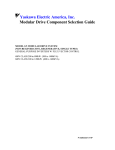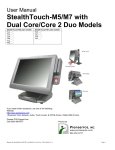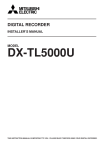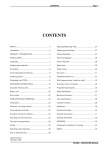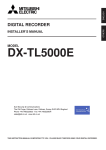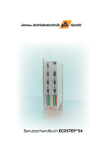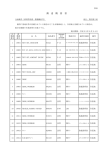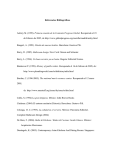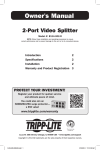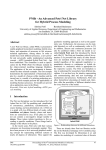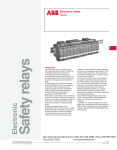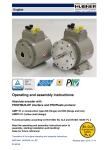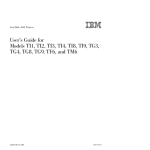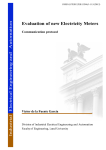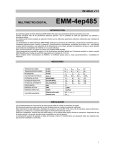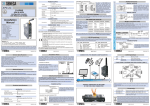Download WM3-96 - CARREMM CONTROLS LTD
Transcript
CARLO GAVAZZI CONTROLS WM3-96 Total pages: 36 Serial Protocol V1 R3 WM3-96 (rev. B02 and following) WM3-96 N2 (rev. C01 and following) SERIAL COMMUNICATION PROTOCOL Vers. 1 Rev. 3 July 7th, 2005 CARLO GAVAZZI CONTROLS WM3-96 Serial Protocol V1 R3 Index Index .........................................................................................................................................2 SERIAL COMMUNICATION PROTOCOL ....................................................................................3 INTRODUCTION.........................................................................................................................3 FUNCTIONS ...............................................................................................................................3 MEMORY AREA .........................................................................................................................5 RAM VARIABLES MAP ..............................................................................................................5 INSTANTANEOUS VARIABLES MAP .....................................................................................................5 VARIABLE FORMAT.........................................................................................................................6 INSTANTANEOUS VARIABLES READING ..............................................................................................7 ENERGY COUNTERS MAP.........................................................................................................8 READING OF THE ENERGY COUNTER VALUES ...................................................................... 10 WRITING OF THE ENERGY COUNTER VALUES ....................................................................... 11 ENERGY COUNTERS RESET COMMANDS .............................................................................. 11 ALARM STATUS MAP..................................................................................................................... 12 READING OF ALARM, DIAGNOSTIC AND REMOTE CONTROL OUTPUT STATUS ................................ 12 WRITE COMMAND FO R R EMOTE CONTROL OUTPUT.................................................................. 15 FORMAT OF THE “PRESENT MODULES” VA RIABLE................................................................... 16 HARMONIC ANALYSIS MA P ............................................................................................................. 18 R EADING OF THE HARMONIC DATA : EXAMPLES .................................................................................. 19 EEPROM VARIABLE MAP ....................................................................................................... 20 EVENT LOGGING..................................................................................................................... 23 MONTHLY ENERGY COUNTERS ................................................................................................2 EEPROM CONFIGURATION DATA FORMAT .............................................................................6 EXAMPLES: HOW TO READ THE DATA FROM EEPROM .......................................................... 10 READING AND RESETTING MAXIMUM AND MINUMUM............................................................................ 10 EVENTS READING ..................................................................................................................... 12 CRC CALCULATION ALGORITHM ........................................................................................... 14 HARDWARE SPECIFICATIONS ............................................................................................... 15 RS485 INTERFACE ...................................................................................................................... 15 RS232 INTERFACE ...................................................................................................................... 17 2 WM3-96 CARLO GAVAZZI CONTROLS Serial Protocol V1 R3 SERIAL COMMUNICATION PROTOCOL INTRODUCTION WM3-96 can be equipped with a RS485 or RS232 serial interface. The serial communication protocol, MODBUS-RTU, is the same on both interfaces. When using RS485, it is possible to connect up to 255 instruments using MODBUS protocol. When using RS232 it is only possible to connect a single instrument (multidrop feature is not available). The time-out for the answer is fixed in 300 ms. The command’s structure of the protocol allows the user to read and write from/in the µP RAM memory, the EEPROM (measured data, stored data, real time clock), so that all the functions are completely transparent. The communication parameters are configurable when using the RS485 interface while are fixed when using the RS232 one, in accordance with the following table: Interface RS232 RS485 Baud rate (bps) Parity Stop bit 9600 None 1 1200 None, even, odd 1 2400 None, even, odd 1 4800 None, even, odd 1 9600 None, even, odd 1 NOTE: please refer to the instruction manual for any detail on the instrument programming. The communication can be started only by the HOST unit, which sends the request frame. Each frame contains the following information: • slave address: is a number from 1 to 255, which identifies the instrument connected to the network. Address 0 (zero) is accepted (in write frames only) by all the instruments, which will execute the relevant command but won’t send any answer frame. NOTE: The request frame must always contain the address even if, when using RS232, it is not considered (every legal value is accepted). • command: it defines the command type (e.g. read function, write function etc.). • data fields: these numbers define the operating parameters of the command (e.g. the address of the word, the value of the word to be written, etc.). • CRC word: it allows to detect transmission errors that may occur. CRC calculation is carried out by the MASTER unit once it has defined address, command and data fields. When the frame is received by the SLAVE, it is stored in a temporary buffer. The CRC is calculated and then compared with the received one. If they correspond and the address is recognised by the SLAVE unit, the command is executed and an answer frame is sent. If the CRC is not correct, the frame is discarded and no answer is sent. FUNCTIONS WM3-96 accepts the following three commands: • Read words (code 04) • Write one word (code 06) • Send a check frame (code 08) Function 04 (read words) Request frame Address 1 byte from 1 to 255 Function 1 byte 04h Data address 2 byte MSB LSB n° of words 2 byte MSB LSB CRC 2 byte MSB LSB 3 WM3-96 CARLO GAVAZZI CONTROLS Serial Protocol V1 R3 NOTE: - The maximum number of word is 120 (240 byte). - The address 00 is not allowed (it generates no answer) Answer frame Address 1 byte from 1 to 255 Function 1 byte 04h n° byte (=2 x n° word) 1 byte MSB LSB Values n° byte (=2 x n° word) … CRC 2 byte MSB LSB Function 06 (write one word) Request frame Address 1 byte from 1 to 255 Function 1 byte 06h Data address 2 byte MSB LSB Value 2 byte MSB LSB CRC 2 byte MSB LSB Answer frame Address 1 byte from 1 to 255 Function 1 byte 06h Data address 2 byte MSB LSB Value 2 byte MSB LSB CRC 2 byte MSB LSB NOTE: the answer frame is an echo of the request frame, which confirm the execution of the command. The write function cannot be used to modify the contents of the energy counter memory area. Function 08 (send a check frame) Request frame Address 1 byte From 1 to 255 Function 1 byte 08h Diagnostic code 2 byte 00h 00h Answer frame Address 1 byte From 1 to 255 Function 1 byte 08h Diagnostic code 2 byte 00h 00h Value 2 byte AAh 55h CRC 2 byte MSB LSB 55h CRC 2 byte MSB LSB Value 2 byte AAh NOTE: the answer frame is an echo of the request frame, which confirm the execution of the command. IMPORTANT: if the address is 00 (zero) all the instruments connected to the network will execute the command but won’t send an answer frame. If the request frame contains an invalid function, the answer frame will be an “exception response”. Exception response Address Function 1 byte 1 byte From 1 to 255 88h Diagnostic code 2 byte 00h 00h Value 2 byte AAh 55h CRC 2 byte MSB LSB 4 WM3-96 CARLO GAVAZZI CONTROLS Serial Protocol V1 R3 MEMORY AREA WM3-96 manages four different memory areas addressed as follows: Memory area Internal RAM Internal RAM Data storage EEPROM Real Time Clock 0000h 00E8h 2000h 4000h Area 00E7h 1fffh 3fffh 5fffh Byte reading order MSB,LSB LSB,MSB MSB,LSB LSB The bytes which are included in the answer frame following a read request of a short or int variable stored in the internal RAM from address 00E8h to address 1FFFh are sent in the following order: LSB, …, …, MSB. NOTE: in the following pages the following notation will be used: 1 int = 4 byte; 1 short = 2 byte; 1 word = 2 byte; 1 byte = 8 bit. RAM VARIABLES MAP INSTANTANEOUS VARIABLES MAP Word 1 2 3 4 5 6 7 8 9 10 11 12 13 14 15 16 17 18 19 20 21 22 23 24 25 26 27 28 29 ADDRESS 000 004 008 00C 010 014 018 01C 020 024 028 02C 030 034 038 03C 040 044 048 04C 050 054 058 05C 060 064 068 06C 070 30 074 BYTE 4 4 4 4 4 4 4 4 4 4 4 4 4 4 4 4 4 4 4 4 4 4 4 4 4 4 4 4 4 4 VARIABLE V L1-N A L1 W L1 V L2-N A L2 W L2 V L3-N A L3 W L3 V L1 V L2 V L3 VA L1 var L1 PF L1 VA L2 var L2 PF L2 VA L3 var L3 PF L3 V ∑ A n W ∑ VA ∑ var ∑ PF ∑ THD V1 THDe V1 Type V A P V A P V A P V V V P P C P P C P P C V A P P P C D D THDo V1 D Word 31 32 33 34 35 36 37 38 39 40 41 42 43 44 45 46 47 48 49 50 51 52 53 54 55 56 57 58 59 ADDRESS BYTE 078 4 07C 4 080 4 084 4 088 4 08C 4 090 4 094 4 098 4 09C 4 0A0 4 0A4 4 0A8 4 0AC 4 0B0 4 0B4 4 0B8 4 0BC 4 0C0 4 0C4 4 0C8 4 0CC 4 0D0 4 4 4 4 4 4 0E8 1+1+ 1+1 VARIABLE THD V2 THDe V2 THDo V2 THD V3 THDe V3 THDo V3 THD A1 THDe A1 THDo A1 THD A2 THDe A2 THDo A2 THD A3 THDe A3 THDo A3 A dmd VA dmd TPF avg W dmd Hz ASY VL-N ∑ UN D D D D D D D D D D D D D D D A P C P H D V V Type Unit V,A/P inf1/2 5 WM3-96 CARLO GAVAZZI CONTROLS Serial Protocol V1 R3 NOTE: all the variables in this table are contiguous. It is possible to read the whole area with a single command sending, in the request frame, 000h as data address and 0076h as number of words (that is 118 in decimal). The values of the instantaneous variables are stored in the addresses from 000h to 0E7h. The data are sent in 4-byte groups in the following order: MSB, ..., ..., LSB. VARIABLE FORMAT The value of all the instantaneous variables is stored as a 4 byte (2 word) int eger value. The decimal point and the multiplier have to be set according to the inf1/2 word coding (see the following table) for voltage (V), current (A) and power (P), in the position “111.1” for the variables of type THD (%) and H (Hz) and in position “1.111” for the variables of type C (PF). The variables “PF L1”, “PF L2”, PF L3”, “PF ∑“ are stored with a positive value if the power factor is “L” (inductive), and with a negative value if the power factor is “C” (capacitive). Variable format info map Address 0E8 0E9 0EA Byte 1 1 1 Variable Info voltage value Info current value Info power value Type inf1 inf1 inf2 Decimal point and multiplier coding INF value d.p 0 1.111m 1 11.11m 2 111.1m 3 1.111 4 11.11 5 111.1 6 1111 7 11.11K INF value d.p 8 111.1k 9 1111k 10 11.11M 11 111.1M 12 1111M 13 11.11G 14 111.1G 15 NOTE: if a power value exceeds 9999, the autoranging function will intervene and modify the inf2 value. If the power value is lower than 99999 the inf2 will be increased of 1 unit, if the power value is greater than 99999 but lower than 999999 the inf2 will be increased of 2 units and so on. Example 1: reading of an int variable stored at address 100h An int variable is 4 byte (2 word) long, so a 2-word read request must be sent: Read command request frame Address Function 1 byte 1 byte from 1 to 255 04 Read command answer frame Address Function n° byte 1 byte 1 byte 1 byte from 1 to 255 04 04 Word address 2 byte 01h 00h n° of words 2 byte 00h 02h Value of int type variable 1° byte 2° byte 3° byte 4° byte LSB MSB CRC 2 byte MSB LSB CRC 2 byte MSB LSB NOTE: Char variables Char type variable (1 byte) must always be read carrying out a 1 word (2 bytes) read request and taking only the needed byte into account. Note that the first byte which is sent is the byte relevant to the specified word address. The following bytes are relevant to the previous address+1. 6 CARLO GAVAZZI CONTROLS WM3-96 Serial Protocol V1 R3 Example 2: reading of 4 char variables (4 bytes=2 words) starting from address 1C0h Read command request frame Address Function 1 byte 1 byte from 1 to 255 04 Read command answer frame Address Function n° byte 1 byte 1 byte 1 byte From 1 to 04 04 255 Word address 2 byte 01h C0h Value 1° byte 01C0h n° of words 2 byte 00h 02h Value 2° byte 01C1h Value 3° byte 01C2h Value request frame (8 byte): 01h 04h 00h 08h 00h 02h CRC CRC Value answer frame (9 byte): 01h 04h 04h 00h 00h 63h 8Dh CRC Info request frame (8 byte): 01h 04h 00h E8h 00h 02h CRC CRC Info answer frame (frame 9 byte): 01h 04h 04h 07h 07h 06h 00h CRC CRC 2 byte MSB LSB Value 4° byte 01C3h CRC 2 byte MSB LSB INSTANTANEOUS VARIABLES READING Example 3: Reading of a single variable: W1 Stored value: Info value (P type): CRC CRC 638Dh (25485 decimal) 06h Since 9999<25485<99999, the inf2 value to be considered is 06+1=07 (11.11K) Variable value (W1): 25.48 kW Example 4: Reading of all the instantaneous variables: All instantaneous values (+ info) request frame (8 byte): 01h 04h 00h 00h 00h 76h CRC CRC 01h All instantaneous values (+ info) answer frame (241 byte): 04h ECh 00h 00h 01h 37h 07h 07h 0Ah VL1-N stored value: ..................... ..................... Info (V type) value: Info (A type) value: Info (P type) value: 0137h (0311 decimal) Variable value (VL1-N): 3.11 03h CRC CRC 07h 07h 0Ah kV 7 WM3-96 CARLO GAVAZZI CONTROLS Serial Protocol V1 R3 ENERGY COUNTERS MAP Table 1 ADDRESS 0EC 0F0 0F4 0F8 0FC 0FD 0FE 0FF 100 104 108 10C 110 114 118 11C 120 124 128 12C 130 134 138 13C 140 144 148 14C 150 154 158 15C 160 164 168 16C 170 174 178 17C 180 184 188 18C 190 194 198 19C 1A0 1A4 1A8 1AC 1B0 1B4 1B8 1BC BYTE 4 4 4 4 1 1 1 1 4 4 4 4 4 4 4 4 4 4 4 4 4 4 4 4 4 4 4 4 4 4 4 4 4 4 4 4 4 4 4 4 4 4 4 4 4 4 4 4 4 4 4 4 4 4 4 4 SEASON TOTALE WINTER PERIOD 1 2 3 4 SUMMER 1 2 3 4 HOLYDAY 1 2 3 4 COUNTER TYPE KWh+ (LSB) KWh(LSB) KVARh+ (LSB) KVARh- (LSB) KWh+ (MSB) KWh(MSB) KVARh+ (MSB) KVARh- (MSB) KWh+ (LSB) KWh(LSB) KVARh+ (LSB) KVARh- (LSB) KWh+ (LSB) KWh(LSB) KVARh+ (LSB) KVARh- (LSB) KWh+ (LSB) KWh(LSB) KVARh+ (LSB) KVARh- (LSB) KWh+ (LSB) KWh(LSB) KVARh+ (LSB) KVARh- (LSB) KWh+ (LSB) KWh(LSB) KVARh+ (LSB) KVARh- (LSB) KWh+ (LSB) KWh(LSB) KVARh+ (LSB) KVARh- (LSB) KWh+ (LSB) KWh(LSB) KVARh+ (LSB) KVARh- (LSB) KWh+ (LSB) KWh(LSB) KVARh+ (LSB) KVARh- (LSB) KWh+ (LSB) KWh(LSB) KVARh+ (LSB) KVARh- (LSB) KWh+ (LSB) KWh(LSB) KVARh+ (LSB) KVARh- (LSB) KWh+ (LSB) KWh(LSB) KVARh+ (LSB) KVARh- (LSB) KWh+ (LSB) KWh(LSB) KVARh+ (LSB) KVARh- (LSB) 8 WM3-96 CARLO GAVAZZI CONTROLS Serial Protocol V1 R3 Table 2 ADDRESS 8EC 8ED 8EE 8EF 8F0 8F1 8F2 8F3 8F4 8F5 8F6 8F7 8F8 8F9 8FA 8FB 8FC 8FD 8FE 8FF 900 901 902 903 904 905 906 907 908 909 90A 90B 90C 90D 90E 90F 910 911 912 913 914 915 916 917 918 919 91A 91B BYTE 1 1 1 1 1 1 1 1 1 1 1 1 1 1 1 1 1 1 1 1 1 1 1 1 1 1 1 1 1 1 1 1 1 1 1 1 1 1 1 1 1 1 1 1 1 1 1 1 SEASON WINTER PERIOD 1 2 3 4 SUMMER 1 2 3 4 HOLYDAY 1 2 3 4 COUNTER TYPE KWh+ (MSB) KWh(MSB) KVARh+ (MSB) KVARh- (MSB) KWh+ (MSB) KWh(MSB) KVARh+ (MSB) KVARh- (MSB) KWh+ (MSB) KWh(MSB) KVARh+ (MSB) KVARh- (MSB) KWh+ (MSB) KWh(MSB) KVARh+ (MSB) KVARh- (MSB) KWh+ (MSB) KWh(MSB) KVARh+ (MSB) KVARh- (MSB) KWh+ (MSB) KWh(MSB) KVARh+ (MSB) KVARh- (MSB) KWh+ (MSB) KWh(MSB) KVARh+ (MSB) KVARh- (MSB) KWh+ (MSB) KWh(MSB) KVARh+ (MSB) KVARh- (MSB) KWh+ (MSB) KWh(MSB) KVARh+ (MSB) KVARh- (MSB) KWh+ (MSB) KWh(MSB) KVARh+ (MSB) KVARh- (MSB) KWh+ (MSB) KWh(MSB) KVARh+ (MSB) KVARh- (MSB) KWh+ (MSB) KWh(MSB) KVARh+ (MSB) KVARh- (MSB) A further table, relevant to the monthly energy counters, will be explained afterwards. NOTE: Table 1 and Table 2 are not contiguous. The variables included in each table are contiguous, so that it is possible to read every variables with two request frames. With the first request frame the 106 words included in Table 1 could be read, with the second request frame the 24 words included in Table 2 could be read. The values of all the total and partial energy counters are stored as a 5-byte integer (the first 4 bytes th are the less significant part, the 5 is the most significant one). The resolution of the counters is 10W 9 CARLO GAVAZZI CONTROLS WM3-96 Serial Protocol V1 R3 (the decimal point position has to be set to “1.11Kwh (Kvarh)”). th Whereas the total counters MSB (5 byte) is contiguous to the less significant bytes, the partial th counters MSB (5 byte) is stored in a different area of the memory. For this reason it is required to carry out two different read commands in order to get all the energy counter information. READING OF THE ENERGY COUNTER VALUES 8-bytes request frame (read command, 10 word): CRC CRC 01h 04h 00h ECh 00h 0Ah 25-bytes answer frame (read command): 1 2 3 4 ECh EDh EEh EFh 01h 04h 14h 00h 00h 00h 00h 11 F6h 00h 12 13 F7h F8h 00h BEh 14 F9h FEh 5 F0h 94h 6 F1h 59h 15 16 17 18 19 FAh FBh FCh FDh Feh FFh FFh 00h 00h 00h 7 8 F2h F3h FFh FFh 9 F4h 94h 20 FFh 00h CRC CRC 10 F5h 02h Starting from address ECh, it is possible to read all the energy counters by means of a single read command (10 word, see the example above). Reconstruction of the kWh+ total counter The first 4 data bytes (less significant bytes) have to be placed side by side in the opposite order: 4 Efh 00h 3 EEh 00h 2 EDh 00h 1 ECh 00h 00000000h=0 The obtained 32-bit value has to be interpreted as a two’s complement value. The relevant kWh+ MSB (byte n° 17), which has to be interpreted as a two’s complement value too, must be multiplied by 1000000000 (decimal value). The result has to be algebraically added to the previous value. 17 FCh 00h 1000000000*0=0 Finally the last result has to be divided by 100. 0+0/100=0 kWh Example 5: reconstruction of the kWh- total counter 5 F0h 94h 6 F1h 59h 7 F2h FFh 8 F3h FFh FF FF 59 94h = -42604 18 FDh 00h 10 CARLO GAVAZZI CONTROLS WM3-96 Serial Protocol V1 R3 1000000000*0 = 0 (- 42604 + 0*1000000000)/100 = - 426.04 kWh WRITING OF THE ENERGY COUNTER VALUES The user is not allowed to write in the energy counter memory area. It is only possible to reset the energy counter using fixed frames. ENERGY COUNTERS RESET COMMANDS The fixed frames to be used to reset the energy counters are listed below: 1. General reset command (reset of all the total, partial and monthly counters) Reset request frame (8 byte): 01h 06h 00h ECh D4h F0h CRC CRC Reset answer frame (8 byte): 01h 06h 00h ECh D4h F0h CRC CRC 2. Total positive energy counters (kWh+ and kvarh+) and monthly counters reset command Reset request frame (8 byte): 01h 06h 01h 00h A5h F0h CRC CRC Reset answer frame (8 byte): 01h 06h 01h 00h A5h F0h CRC CRC 3. Total negative energy counters (kWh- and kvarh-) and monthly counters reset command Reset request frame (8 byte): 01h 06h 01h 04h 23h 44h CRC CRC Reset answer frame (8 byte): 01h 06h 01h 04h 23h 44h CRC CRC 4. Partial positive energy counters (kWh+ and kvarh+) and monthly counters reset command Reset request frame (8 byte): 01h 06h 01h 08h 87h 35h CRC CRC Reset answer frame (8 byte): 01h 06h 01h 08h 87h 35h CRC CRC 5. Partial negative energy counters (kWh- and kvarh-) and monthly counters reset command Reset request frame (8 byte): 01h 06h 01h C0h 59h 12h CRC CRC Reset answer frame (8 byte): 01h 06h 01h C0h 59h 12h CRC CRC 11 CARLO GAVAZZI CONTROLS WM3-96 Serial Protocol V1 R3 ALARM STATUS MAP Table 3 ADDRESS 1C0 1C2 1C4 1C6 1C8 1CA 1CC 1CE 1D0 1D2 1D4 1D6 1D8 1DA 1DC 1DE 1E0 1E2 1E4 1E6 1E8 1EA 1EC 1EE 1F0 1F2 1F4 1F6 BYTE 1+1 1+1 1+1 1+1 2 2 2 2 2 2 2 2 2 2 2 2 2 2 2 2 2 2 2 2 2 2 2 2 Variable type Diagn0 , diagn1 Diagn2 , diagn3 Alarm0 , alarm1 Alarm2 , alarm3 control 0 type control 1 type control 2 type control 3 type status Relay 0 status Relay 1 status Relay 2 status Relay 3 Variable associated to Variable associated to Variable associated to Variable associated to ON set-point 0 ON set-point 1 ON set-point 2 ON set-point 3 OFF set-point 0 OFF set-point 1 OFF set-point 2 OFF set-point 3 delay 0 delay 1 delay 2 delay 3 alarm alarm alarm alarm 0 1 2 3 Table 4 ADDRESS 8DC 8DE BYTE 1+1 1+1 Variable type Remote 1, Remote 2 Remote 3, Remote 4 NOTE: the variables included in each of the previous tables are contiguous, so it is possible to read every variables with two request frames. With the first request frame the 28 words included in Table 3 can be read, with the second request frame the 2 words included in Table 4 can be read. In order to know the current digital output settings, see the EEPROM map paragraph. READING OF ALARM, DIAGNOSTIC AND REMOTE CONTROL OUTPUT STATUS th The n digital output can work as pulse output, alarm output, diagnostic output or remote control output. th th In order to know if the n digital output is set as alarm, the n alarm byte (“alarm n”) must be read. If the byte is equal to 0 it means that the digital output is not set as alarm, if it is equal to 1 the alarm status is OFF, if it is equal to 2 the alarm status is ON. The same considerations are valid in case of diagnostic output (“diagn n” byte must be read) or remote control output (“Remote n” byte must be read). Of course, only one among “alarm n”, “diagn n” and “remote n” byte can be different from 0. If all th these three bytes are equal to 0, it means that the n digital output is set as pulse output. 12 WM3-96 CARLO GAVAZZI CONTROLS Serial Protocol V1 R3 The values stored in addresses from 1C8h to 1CEh explain the control type, coded as follows: 0 = UP 1 = UP-LATCH 2 = DOWN 3 = DOWN LATCH The values stored in addresses from 1D0h to 1D6h explain if the relay is normally energised or deenergized: 0 = Normally de-energized 1 = Normally energized In the addresses from 1D8h to 1DEh the variables associated to the alarms are stored, according to the “Variable type coding” table (see page 28). Example: if a control on variable W1 has been associated to alarm1, in the address 1DAh the value 12 must be stored The Set-point ON and OFF values are stored as unsigned short. The delay values are stored as short and must be included in the range from 0 to 255 seconds. Example 6: “Diagnostic” read command 2-word read command request frame (8 byte): 01h 04h 01h C0h 00h 02h CRC CRC 01h Digital output Digital output Digital output Digital output 0: 1: 2: 3: Read command answer frame (9 byte): 04h 04h 00h 00h 01h 00h CRC CRC NO Diagnostic NO Diagnostic Diagnostic OFF NO Diagnostic Example 7: “Alarm” read command 2-word read command request frame (8 byte): 01h 04h 01h C4h 00h 02h CRC CRC 01h Digital output Digital output Digital output Digital output 0: 1: 2: 3: Read command answer frame (9 byte): 04h 04h 00h 01h 00h 00h CRC CRC NO Alarm Alarm OFF NO Alarm NO Alarm 13 WM3-96 CARLO GAVAZZI CONTROLS Serial Protocol V1 R3 Example 8: “Control type” read command 4-word read command request frame (8 byte): 01h 04h 01h C8h 00h 04h CRC CRC 01h Digital Digital Digital Digital output output output output 04h 0: 1: 2: 3: 08h Read command answer frame (13 byte): LSB MSB LSB MSB LSB MSB LSB 00h 00h 00h 00h 00h 00h 00h MSB 00h CRC CRC Not used (digital output 0 is not set as alarm, see previous example) UP control Not used Not used Example 9: “Relay status” read command 4-word read command request frame (8 byte): 01h 04h 01h D0h 00h 04h CRC CRC 01h Digital Digital Digital Digital output output output output 04h 0: 1: 2: 3: 08h Read command answer frame (13 byte): 00h 00h 01h 00h 00h 00h 00h 00h CRC CRC Not used (digital output 0 is not set as alarm, see example 7) Normally energized Not used Not used Example 10: “Variable associated to the alarm” read command 4-word read command request frame (8 byte): 01h 04h 01h D8h 00h 04h CRC CRC 01h 04h Digital output 0: Digital output 1: Digital output 2: Digital output 3: 08h Read command answer frame (13 byte): 00h 00h 26h 00h 00h 00h 00h 00h CRC CRC not used (digital output 0 is not set as alarm, see example 7) THD A1 not used not used Example 11: “ON Set-point” (alarm activation) read command 4-word read command request frame (8 byte): 01h 04h 01h E0h 00h 04h CRC CRC 01h Digital Digital Digital Digital output output output output 0: 1: 2: 3: 04h 08h Read command answer frame (13 byte): 00h 00h 64h 00h 00h 00h 00h 00h CRC CRC not used (digital output 0 is not set as alarm, see example 7) 10.0% (0064h = 100 decimal) not used not used 14 WM3-96 CARLO GAVAZZI CONTROLS Serial Protocol V1 R3 Example 12: “OFF Set-point” (alarm deactivation) read command 4-word read command request frame (8 byte): 01h 04h 01h E8h 00h 04h CRC CRC 01h Digital Digital Digital Digital output output output output 04h 0: 1: 2: 3: 08h Read command answer frame (13 byte): 00h 00h 32h 00h 00h 00h 00h 00h CRC CRC not used (digital output 0 is not set as alarm, see example 7) 5.0% (0032h = 50 decimal) not used not used Example 13: “Alarm activation delay” read command 4-word read command request frame (8 byte): 01h 04h 01h F0h 00h 04h CRC CRC 01h Digital Digital Digital Digital output output output output 0: 1: 2: 3: 04h 08h Read command answer frame (13 byte): 00h 00h 04h 00h 00h 00h 00h 00h CRC CRC not used (digital output 0 is not set as alarm, see example 7) 4 seconds not used not used Example 14: “Latch alarm” reset command To reset a UP -LATCH or DOWN-LATCH alarm, the relevant alarm byte must be set to 1. 01h Reset command request frame (8 byte): 06h 01h C4h 00h 01h CRC CRC 01h Reset command answer frame (8 byte): 06h 01h C4h 00h 01h CRC CRC To reset the alarm 1, the byte at address 01C5h must be set to 1. The byte at address 01C4h must be set to 00h, since it is relevant to alarm 0. WRITE COMMAND FOR REMOTE CONTROL OUTPUT The remote control digital output memory area is described in Table 4 and consists in 4 bytes starting from address 08DCh (Remote1=8DCh, Remote2=8DDh, and so on). th To switch ON the n remote control output, the value 02h must be written in the “Remote n” byte, th while to switch OFF the n remote control output, the value 01h must be written in the “Remote n” byte. Note again that the write command always writes 1 word (2 bytes). Request frame: R1 = ON and R2 = OFF (8 byte): 01h 06h 08h DCh 02h 01h CRC CRC Answer frame (8 byte): 01h 06h 08h DCh 02h 01h CRC CRC 15 WM3-96 CARLO GAVAZZI CONTROLS Serial Protocol V1 R3 Request frame: R1 = OFF and R2 = OFF (8 byte): 01h 06h 08h DCh 01h 01h CRC CRC Answer frame (8 byte): 01h 06h 08h DCh 01h 01h CRC CRC NOTE: a digital output can be used as remote control output only if the relevant “digital output type” variable stored in EEPROM is correctly set (see page 20 and following). FORMAT OF THE “PRESENT MODULES” VARIABLE ADDRESS 800 BYTE 2 Code bit15 bit14 bit13 In3 In2 Code XXXXXXXXXXXXXXXX bit12 bit11 In1 bit10 bit9 Bit8 S3 Variable type Module bit7 S4 bit6 S2 bit5 232 bit4 bit3 CLK 485 bit2 bit1 bit0 AG34 AG12 Ing_d Inputs Ing_d Input module 0 Not present 1 Present Analogue output AG12 Analogue (out 1, 2) module 0 Not present 1 Present AG34 Analogue (out 3, 4) module 0 Not present 1 Present Serial 485 0 1 output RS485 module Not present Present 232 0 1 RS232 module Not present Present CLK 0 1 RTC Clock Not present Present 16 WM3-96 CARLO GAVAZZI CONTROLS Digital S3A 0 0 0 0 1 1 1 1 output code S4A S2A 0 0 0 1 1 0 1 1 0 0 0 1 1 0 1 1 Digital In1 0 1 inputs code Digital input 1 ON OFF In2 0 1 Digital input 2 ON OFF In3 0 1 Digital input 3 ON OFF Serial Protocol V1 R3 Available digital outputs on the inserted modules 1,2,3,4 1,2,3,4 1,2,3,4 1,2 3,4 3,4 1,2,3,4 None Example 15: reading of the “present modules” variable 01h 1-word read request frame (8 byte) 04h 08h 00h 00h 01h CRC 01h 1-word read answer frmae (8 byte): 04h 02h 5Bh 61h CRC CRC CRC Module variable value: 615Bh = 0110000101011011 Available modules: input module, digital inputs, analogue output AG12, RS485, clock, digital output 3,4, Digital inputs: ln3=OFF (open contact), ln2=OFF, ln1=ON (close contact) 17 WM3-96 CARLO GAVAZZI CONTROLS Serial Protocol V1 R3 HARMONIC ANALYSIS MAP Voltages1 (%) ORDER/ VARIAB. THD Relative angles2 (°) Currents (%) 1° L1-N ADD. 220 234 L2-N ADD. 222 236 L3-N ADD. 224 238 L1 ADD. 226 23A L2 ADD. 228 23C L3 ADD. 22A 23E L1 ADD. L2 ADD. L3 ADD. 240 242 244 2° 248 24A 24C 24E 250 252 254 256 258 3° 25C 25E 260 262 264 266 268 26A 26C 4° 270 272 274 276 278 27A 27C 27E 280 5° 284 286 288 28A 28C 28E 290 292 294 6° 298 29A 29C 29E 2A0 2A2 2A4 2A6 2A8 7° 8° 9° 10° 11° 12° 13° 14° 15° 16° 17° 18° 19° 20° 21° 22° 23° 24° 25° 26° 27° 28° 29° 30° 31° 32° 33° 34° 35° 36° 37° 38° 39° 40° 41° 42° 43° 44° 45° 46° 47° 48° 49° 50° 2AC 2AE 2B0 2B2 2B4 2B6 2B8 2BA 2BC 2C0 2C2 2C4 2C6 2C8 2CA 2CC 2CE 2D0 2D4 2D6 2D8 2DA 2DC 2DE 2E0 2E2 2E4 2E8 2EA 2EC 2EE 2F0 2F2 2F4 2F6 2F8 2FC 2FE 300 302 304 306 308 30A 30C 310 312 314 316 318 31A 31C 31E 320 324 326 328 32A 32C 32E 330 332 334 338 33A 33C 33E 340 342 344 346 348 34C 34E 350 352 354 356 358 35A 35C 360 362 364 366 368 36A 36C 36E 370 374 376 378 37A 37C 37E 380 382 384 388 38A 38C 38E 390 392 394 396 398 39C 39E 3A0 3A2 3A4 3A6 3A8 3AA 3AC 3B0 3B2 3B4 3B6 3B8 3BA 3BC 3BE 3C0 3C4 3C6 3C8 3CA 3CC 3CE 3D0 3D2 3D4 3D8 3DA 3DC 3DE 3E0 3E2 3E4 3E6 3E8 3EC 3EE 3F0 3F2 3F4 3F6 3F8 3FA 3FC 400 402 404 406 408 40A 40C 40E 410 414 416 418 41A 41C 41E 420 422 424 428 42A 42C 42E 430 432 434 436 438 43C 43E 440 442 444 446 448 44A 44C 450 452 454 456 458 45A 45C 45E 460 464 466 468 46A 46C 46E 470 472 474 478 47A 47C 47E 480 482 484 486 488 48C 48E 490 492 494 496 498 49A 49C 4A0 4A2 4A4 4A6 4A8 4AA 4AC 4AE 4B0 4B4 4B6 4B8 4BA 4BC 4BE 4C0 4C2 4C4 4C8 4CA 4CC 4CE 4D0 4D2 4D4 4D6 4D8 4DC 4DE 4E0 4E2 4E4 4E6 4E8 4EA 4EC 4F0 4F2 4F4 4F6 4F8 4FA 4FC 4FE 500 504 506 508 50A 50C 50E 510 512 514 518 51A 51C 51E 520 522 524 526 528 52C 52E 530 532 534 536 538 53A 53C 540 542 544 546 548 54A 54C 54E 550 554 556 558 55A 55C 55E 560 562 564 568 56A 56C 56E 570 572 574 576 578 57C 57E 580 582 584 586 588 58A 58C 590 592 594 596 598 59A 59C 59E 5A0 5A4 5A6 5A8 5AA 5AC 5AE 5B0 5B2 5B4 5B8 5BA 5BC 5BE 5C0 5C2 5C4 5C6 5C8 5CC 5CE 5D0 5D2 5D4 5D6 5D8 5DA 5DC 5E0 5E2 5E4 5E6 5E8 5EA 5EC 5EE 5F0 5F4 5F6 5F8 5FA 5FC 5FE 600 602 604 608 60A 60C 60E 610 612 614 616 618 THDo THDe 61C 630 61E 632 620 634 622 636 624 638 626 63A 18 WM3-96 CARLO GAVAZZI CONTROLS Serial Protocol V1 R3 NOTE: 1 According to the selected electrical system, the voltages can be Phase to Phase Voltage or Phase to Neutral Voltages. 2 Negligible values when the selected system is without neutral. All the variables of the previous table are contiguous. Since the read command can read at most 120 words, it is possible to read all the harmonic analysis values with at least four request frames. The values of the harmonic and distortion variables are represented as short (2 byte long). The decimal point must be set to “111.1” for distortion and angle variables (THD, THDo, THDe), and to “111.11” for the harmonic variables (h). The stored values have physical meaning only if the harmonic analysis of the relevant phase is enabled (please refer to the user manual for FFT enable function). READING OF THE HARMONIC DATA: EXAMPLES rd Example 16: reading of the VL1 3 order harmonic 01h “Value” request frame (frame 8 byte): 04h 02h 5Ch 00h 01h CRC CRC “Value” answer frame (frame 7 byte): 01h 04h 02h 13h 0Dh CRC CRC Variable value: Value format: rd VL1 3 order harmonic value 0D13h 111.11 33.47% 3347 (decimal) (the display shows 33.4%) rd Example 17: reading of the phase 1 - 3 01h order relative angle “Value” read request frame (frame 8 byte): 04h 02h 68h 00h 01h CRC CRC “Value” read answer frame (frame 7 byte): 01h 04h 02h EFh 06h CRC CRC Variable value: 06EFh Value format: 111.1 rd Phase 1–3 order relative angle:177.5° 1775 (decimal) (the display shows 177°) 19 WM3-96 CARLO GAVAZZI CONTROLS Serial Protocol V1 R3 EEPROM VARIABLE MAP NOTE: f.s. means full scale; b.s. means beginning of the scale WM3-96 configuration map ADD. 2000 2002 2004 2006 2008 200A 200C 200E 2010 2012 2014 2016 2018 201A 201C 201E 2020 2022 2024 2026 2028 202A 202C 202E 2030 2032 2034 2036 2038 203A 203C 203E 2040 2042 2044 2046 2048 204A 204C 204E 2050 2052 2054 2056 2058 205A 205C 205E 2060 2062 2064 2066 VARIABLE Password System CT VT type avg time avg enable FFT type digit field 1 e 2 field 3 e 4 RS485: address RS485: baud rate RS485: parity Reserved filter range filter coeff. event selection event selection USA/EUROclockformat Language Pulse type selection dig. out type Pulses/KWh out1 Pulses/KWh out2 Pulses/KWh out3 Pulses/KWh out4 info dig. out 1 Delay out 1 set-point out 1 Hysteresis out 1 info dig. out 2 delay out 2 set-point out 2 Hysteresis out 2 info dig. out 3 delay out 3 set-point out 3 Hysteresis out 3 info dig. out 4 delay out 4 set-point out 4 Hysteresis out 4 MAX 500 4 60000 60000 1 30 MIN 0 0 1 1 0 1 DEFAULT 0 2 10 10 0 15 See EEPROM data format tables 1 0 0 See EEPROM data format tables See EEPROM data format tables 255 3 2 1 0 0 1 3 0 1000 255 1 1 10 3 BIT CHECK 0101XXXX XXXXXXXX 0101XXXX XXXXXXXX not present not present 0101XXXX XXXXXXXX 0101XXXX XXXXXXXX 0100XXXX XXXXXXXX 0101XXXX XXXXXXXX 0101XXXX XXXXXXXX 0101XXXX XXXXXXXX not present not present not present not present not present XXXXXXXX XXXXXXXX XXXXXXXX XXXXXXXX See EEPROM data format tables See EEPROM data format tables See EEPROM data format tables 0101XXXX XXXXXXXX 0101XXXX XXXXXXXX XXXXXXXX XXXXXXXX See EEPROM data format tables not present 01XXXXXX XXXXXXXX 01XXXXXX XXXXXXXX 01XXXXXX XXXXXXXX 01XXXXXX XXXXXXXX not present not present 01XXXXXX XXXXXXXX 01XXXXXX XXXXXXXX not present not present 01XXXXXX XXXXXXXX 01XXXXXX XXXXXXXX not present not present 01XXXXXX XXXXXXXX 01XXXXXX XXXXXXXX not present not present 01XXXXXX XXXXXXXX 01XXXXXX XXXXXXXX 1000 1000 1000 1000 1 1 1 1 1 1 1 1 See EEPROM data format tables 255 f.s f.s 0 b.s. 0 0 0 0 See EEPROM data format tables 255 f.s f.s 0 b.s. 0 0 0 0 See EEPROM data format tables 255 f.s f.s 0 b.s. 0 0 0 0 See EEPROM data format tables 255 f.s f.s 0 b.s. 0 0 0 0 20 WM3-96 CARLO GAVAZZI CONTROLS Serial Protocol V1 R3 WM3-96 configuration map (continue) ADD. 2080 2082 2084 2086 2088 208A 208C 208E 2090 2092 2094 2096 2098 209A 209C 209E 20A0 20A2 20A4 20A6 20A8 20AA 20AC 20AE 20B0 20B2 20B4 20B6 20B8 20BA 20BC 20BE 20C0 20C2 20C4 20C6 20C8 20CA 20CC 20CE 20D0 20D2 20D4 20D6 20D8 20DA 20DC 20DE 20E0 20E2 20E4 20E6 VARIABLE MAX info analog out 1 See EEPROM min % an. out 1 1000 max % an. out 1 1000 min input out 1 f.s. max input 1 f.s. See EEPROM info an. out 2 min % an. out 2 1000 max % an. out 2 1000 min input out 2 f.s. max input out 2 f.s. See EEPROM info an. out 3 min % an. out 3 1000 max % an. out 3 1000 min input out 3 f.s. max input out 3 f.s. See EEPROM info an. out 4 min % an. out 4 1000 max % an. out 4 1000 min input out 4 f.s. max input out 4 f.s. type type type type type type type type type type type type type type type type type type type type MAX1 MAX2 MAX3 MAX4 MAX5 MAX6 MAX7 MAX8 MAX9 MAX10 MAX11 MAX12 MIN1 MIN2 MIN3 MIN4 MIN5 MIN6 MIN7 MIN8 ----------------------------------------- MIN DEFAULT data format tables 0 0 b.s. b.s. 0 1000 b.s. f.s. data format tables 0 0 b.s. b.s. 0 1000 b.s. f.s. data format tables 0 0 b.s. b.s. 0 1000 b.s. f.s. data format tables 0 0 b.s. b.s. ----------------------------------------- 0 1000 b.s. f.s. not not not not not not not not not not not not not not not not not not not not BIT CHECK present present present present present present present present present present present present present present present present present present present present 0101XXXX 0101XXXX 0101XXXX 0101XXXX 0101XXXX 0101XXXX 0101XXXX 0101XXXX 0101XXXX 0101XXXX 0101XXXX 0101XXXX 0101XXXX 0101XXXX 0101XXXX 0101XXXX 0101XXXX 0101XXXX 0101XXXX 0101XXXX XXXXXXXX XXXXXXXX XXXXXXXX XXXXXXXX XXXXXXXX XXXXXXXX XXXXXXXX XXXXXXXX XXXXXXXX XXXXXXXX XXXXXXXX XXXXXXXX XXXXXXXX XXXXXXXX XXXXXXXX XXXXXXXX XXXXXXXX XXXXXXXX XXXXXXXX XXXXXXXX 21 WM3-96 CARLO GAVAZZI CONTROLS Serial Protocol V1 R3 WM3-96 configuration map (continue) ADD. 2100 2101 2102 2103 2104 2105 2106 2107 2108 2109 210A 210B 210C 210D 210E 210F 2110 2111 2112 2113 2114 2115 2116 2117 2118 2119 211A 211B 211C 211D 211E 211F 2120 2121 2122 2123 2124 2125 2126 2127 2128 2129 212A 212B 212C 212D 212E 212F val val val val val val val val val val val val val val val val val val val val val val val val VARIABLE MAX1(msb) MAX1(lsb) MAX2(msb) MAX2(lsb) MAX3(msb) MAX3(lsb) MAX4(msb) MAX4(lsb) MAX5(msb) MAX5(lsb) MAX6(msb) MAX6(lsb) MAX7(msb) MAX7(lsb) MAX8(msb) MAX8(lsb) MAX9(msb) MAX9(lsb) MAX10(msb) MAX10(lsb) MAX11(msb) MAX11(lsb) MAX12(msb) MAX12(lsb) val val val val val val val val val val val val val val val val MIN1(msb) MIN1(lsb) MIN2(msb) MIN2(lsb) MIN3(msb) MIN3(lsb) MIN4(msb) MIN4(lsb) MIN5(msb) MIN5(lsb) MIN6(msb) MIN6(lsb) MIN7(msb) MIN7(lsb) MIN8(msb) MIN8(lsb) MAX MIN DEFAULT BIT CHECK 22 WM3-96 CARLO GAVAZZI CONTROLS Serial Protocol V1 R3 EVENT LOGGING Event logging map 2300 2308 2310 2318 2320 2328 4 4 4 4 4 4 … … 31F8 4 words Event 480 th N words words words words words words Event Event Event Event Event Event The stored information relevant to every event are the following: event type, hour, minutes, seconds, day, month, year, value. All these data are included in the relevant 4 words, coded as follow. 1 2 3 4 5 6 To reset the events, it is necessary to write 0 in every of the sideways listed addresses and to reset the event counter, placed at the address 80Ch. … event coding Word1 hour XXXXX min XXXXXX event type XXXXX Word2 month XXXX day XXXXX year XXXXXXX Seconds 0101XXXXXX Word3 variable type XXXXXX value XXXXXXXXXXXXXXXX Word3 Variable type coding Refer to the relevant table in “EEPROM configuration data” chapter. Event type coding: MAX MIN DIAGNOSTIC 1 DIAGNOSTIC 2 DIAGNOSTIC 3 DIAGNOSTIC 4 DIAGNOSTIC 1 DIAGNOSTIC 2 DIAGNOSTIC 3 DIAGNOSTIC 4 REMOTE 1 REMOTE 2 REMOTE 3 ON ON ON ON OFF OFF OFF OFF ON ON ON 1 2 3 4 5 6 7 8 9 10 11 12 13 REMOTE 4 REMOTE 1 REMOTE 2 REMOTE 3 REMOTE 4 ALARM 1 ALARM 2 ALARM 3 ALARM 4 ALARM 1 ALARM 2 ALARM 3 ALARM 4 ON OFF OFF OFF OFF ON ON ON ON OFF OFF OFF OFF 14 15 16 17 18 19 20 21 22 23 24 25 26 23 CARLO GAVAZZI CONTROLS WM3-96 Serial Protocol V1 R3 MONTHLY ENERGY COUNTERS The reading of the values of the energy counters relevant to the previous three months is feasible by reading the data stored in the three tables described below. The tables have the same structure: they are composed of 14 32-bytes pages where the total and partial counter values are stored on the first day of the month at 0.00.00. The storing order of the table is the following (assuming, for example, to begin the WM3 use in January): January data = table A, February data = table B, March data = table C, April data = table A (overwriting the January data), and so on. Pages structure: Page 1: the initial 16 bytes, grouped 4 by 4, are the four-total counter LSB part (KWh+ ,KWh-, Kvarh+, Kvarh-) Page 2: the initial 20 bytes, grouped 5 by 5, are the four-winter tariff 1 partial counters values Page 3: the initial 20 bytes, grouped 5 by 5, are the four-winter tariff 2 partial counters values Page 4: the initial 20 bytes, grouped 5 by 5, are the four-winter tariff 3 partial counters values Page 5: the initial 20 bytes, grouped 5 by 5, are the four-winter tariff 4 partial counters values Page 6: the initial 20 bytes, grouped 5 by 5, are the four-summer tariff 1 partial counters values Page 7: the initial 20 bytes, grouped 5 by 5, are the four-summer tariff 2 partial counters values Page 8: the initial 20 bytes, grouped 5 by 5, are the four-summer tariff 3 partial counters values Page 9: the initial 20 bytes, grouped 5 by 5, are the four-summer tariff 4 partial counters values Page 10: the initial 20 bytes, grouped 5 by 5, are the four-holiday tariff 1 partial counters values Page 11: the initial 20 bytes, grouped 5 by 5, are the four-holiday tariff 2 partial counters values Page 12: the initial 20 bytes, grouped 5 by 5, are the four-holiday tariff 3 partial counters values Page 13: the initial 20 bytes, grouped 5 by 5, are the four-holiday tariff 4 partial counters values Page 14: the initial 4 bytes are the four-total counter MSB part, then 10 not used bytes follow, then the following two bytes are relevant respectively to the year and month when the table were stored. How to reconstruct the energy counter values: The energy values have to be reconstructed according to the procedure described at page 11. The value of byte 5, multiplied by 1000000000, must be added to the byte1-byte2-byte3-byte4 value and the sum divided by 100. - Total counters: byte5 is stored at page 14 of the relevant monthly table. byte1-byte2-byte3-byte4 are stored at page 1 (byte 1 has the lower address). - Partial counters: byte5 and byte1-byte2-byte3-byte4 are consecutively stored starting from the address of the required counter (byte 5 has the lower address, then byte 1 is stored, etc.). To obtain the energy consuption relevant to a given month, the tables relevant to the end and the beginning of that month must be read, and the difference between the respective values must be carried out. 2 WM3-96 CARLO GAVAZZI CONTROLS Serial Protocol V1 R3 Monthly energy counters map ADDRESS 3220 (page 1) 3224 3228 322C 3240 (page 2) 3244 3245 3249 324A 324E 324F 3253 3254 3260 (page 3) 3264 3265 3269 326A 326E 326F 3263 3264 BYTE SEASON 4 TOTAL 4 4 4 4 4 4 4 4 WINTER 1 4 1 4 1 4 1 12 4 WINTER 1 4 1 4 1 4 1 12 PERIOD COUNTER TYPE Kwh+ (LSB) Kwh(LSB) KVARh+ (LSB) KVARh- (LSB) 1 Kwh+ Kwh+ KVARh+ KVARh+ KwhKwhKVARhKVARh- (LSB) (MSB) (LSB) (MSB) (LSB) (MSB) (LSB) (MSB) 2 Kwh+ Kwh+ KVARh+ KVARh+ KwhKwhKVARhKVARh- (LSB) (MSB) (LSB) (MSB) (LSB) (MSB) (LSB) (MSB) … … … … … … … … … … … … … … … 33A0 (page 13) 33A4 33A5 33A9 33AA 33AE 33AF 33B3 33B4 33C0 (page 14) 33C1 33C2 33C3 33C4 33CE 33CF 33D0 4 1 4 1 4 1 4 1 12 1 1 1 1 10 1 1 16 HOLIDAY YEAR/MONTH 4 Kwh+ Kwh+ KVARh+ KVARh+ KwhKwhKVARhKVARh- (LSB) (MSB) (LSB) (MSB) (LSB) (MSB) (LSB) (MSB) Kwh+ KwhKVARh+ KVARh- (MSB) (MSB) (MSB) (MSB) YEAR MONTH Table A 3 WM3-96 CARLO GAVAZZI CONTROLS Serial Protocol V1 R3 Monthly energy counters map ADDRESS 33E0 (page 1) 33E4 33E8 33EC 3400 (page 2) 3404 3405 3409 340A 340E 340F 3413 3414 3420 (page 3) 3424 3425 3429 342A 342E 342F 3433 3434 BYTE SEASON 4 TOTAL 4 4 4 4 4 4 4 4 WINTER 1 4 1 4 1 4 1 12 4 WINTER 1 4 1 4 1 4 1 12 PERIOD COUNTER TYPE Kwh+ (LSB) Kwh(LSB) KVARh+ (LSB) KVARh- (LSB) 1 Kwh+ Kwh+ KVARh+ KVARh+ KwhKwhKVARhKVARh- (LSB) (MSB) (LSB) (MSB) (LSB) (MSB) (LSB) (MSB) 2 Kwh+ Kwh+ KVARh+ KVARh+ KwhKwhKVARhKVARh- (LSB) (MSB) (LSB) (MSB) (LSB) (MSB) (LSB) (MSB) … … … … …. … … … … … … … … … … 3540 (page 13) 3544 3545 3549 354A 354E 354F 3553 3554 3560 (page 14) 3561 3562 3563 3564 356E 356F 3570 4 1 4 1 4 1 4 1 12 1 1 1 1 10 1 1 16 HOLIDAY YEAR/MONTH 4 Kwh+ Kwh+ KVARh+ KVARh+ KwhKwhKVARhKVARh- (LSB) (MSB) (LSB) (MSB) (LSB) (MSB) (LSB) (MSB) Kwh+ KwhKVARh+ KVARh- (MSB) (MSB) (MSB) (MSB) YEAR MONTH Table B 4 WM3-96 CARLO GAVAZZI CONTROLS Serial Protocol V1 R3 Monthly energy counters map ADDRESS 35A0 (page 1) 35A4 35A8 35AC 35C0 (page 2) 35C4 35C5 35C9 35CA 35CE 35CF 35C3 35C4 35E0 (page 3) 35E4 35E5 35E9 35EA 35EE 35EF 35E3 35E4 BYTE SEASON 4 TOTALE 4 4 4 4 4 4 4 4 WINTER 1 4 1 4 1 4 1 12 4 WINTER 1 4 1 4 1 4 1 12 PERIOD COUNTER TYPE Kwh+ (LSB) Kwh(LSB) KVARh+ (LSB) KVARh- (LSB) 1 Kwh+ Kwh+ KVARh+ KVARh+ KwhKwhKVARhKVARh- (LSB) (MSB) (LSB) (MSB) (LSB) (MSB) (LSB) (MSB) 2 Kwh+ Kwh+ KVARh+ KVARh+ KwhKwhKVARhKVARh- (LSB) (MSB) (LSB) (MSB) (LSB) (MSB) (LSB) (MSB) … … … … … … … … … … … … … … … 3720 (page 13) 3724 3725 3729 372A 372E 372F 3733 3734 3740 (page 14) 3741 3742 3743 3744 374E 374F 3750 4 1 4 1 4 1 4 1 12 1 1 1 1 10 1 1 16 HOLIDAY YEAR/MONTH 4 Kwh+ Kwh+ KVARh+ KVARh+ KwhKwhKVARhKVARh- (LSB) (MSB) (LSB) (MSB) (LSB) (MSB) (LSB) (MSB) Kwh+ KwhKVARh+ KVARh- (MSB) (MSB) (MSB) (MSB) YEAR MONTH Table C 5 WM3-96 CARLO GAVAZZI CONTROLS Serial Protocol V1 R3 EEPROM CONFIGURATION DATA FORMAT Variable type coding VARIABLE V L1-N V L2-N V L3-N VL-N ∑ V L1 V L2 V L3 V ∑ A L1 A L2 A L3 A n W L1 W L2 W L3 W ∑ var L1 var L2 var L3 VAR ∑ VA L1 VA L2 VA L3 VA ∑ PF L1 PF L2 CODE 0 1 2 3 4 5 6 7 8 9 10 11 12 13 14 15 16 17 18 19 20 21 22 23 24 25 VARIABLE PF L3 PF ∑ Hz THD V1 THDe V1 THDo V1 THD V2 THDe V2 THDo V2 THD V3 THDe V3 THDo V3 THD A1 THDe A1 THDo A1 THD A2 THDe A2 THDo A2 THD A3 THDe A3 THDo A3 A dmd VA dmd TPF avg W dmd ASY CODE 26 27 28 29 30 31 32 33 34 35 36 37 38 39 40 41 42 43 44 45 46 47 48 49 50 51 System coding system 010XXXXX 010XXXXX 010XXXXX 010XXXXX 010XXXXX XXXXX000 XXXXX001 XXXXX010 XXXXX011 XXXXX100 selection 1-phase 3+N phases bal 3+N phases unbal 3 phases bal 3 phases unbal Average type coding Average type XXXXXXXX XXXXXXX0 XXXXXXXX XXXXXXX1 0101XXXX XXXXXXXX selection avg fixed avg float bit check 6 WM3-96 CARLO GAVAZZI CONTROLS Serial Protocol V1 R3 Info out (1,2,3,4) coding info out XXXXXXXX XXXXXX00 XXXXXX00 XXXXXX00 XXXXXX00 XXXXX0XX XXXXX1XX XX000000 00XXXXXX 01XXXXXX 10XXXXXX 11XXXXXX XXXXXXXX XXXXXXXX selection variable type(from 000000 to 110011, default 110011) control type «up» (default) control type «up.l» control type «do» control type «do.l» normally de-energized relay normally energized relay Field n coding The field n (n = 0, 1, 2, 3) variables are the variables chosen by the user to be shown on page 0 of the WM3 display. Field (1 and 2) coding Field XXXXXXXX XX000000 XXXX0000 00XXXXXX 0101XXXX XXXXXXXX selection field 1 variable field 2 variable bit check Field (3 and 4) coding Field XXXXXXXX XX000000 XXXX0000 00XXXXXX 0101XXXX XXXXXXXX selection field 3 variable field 4 variable bit check MAX and MIN type coding MAX and MIN type XXXXXXXX XX000000 0101XXXX XXXXXXXX selection field 1 variable (from 000000 to 110011, see TABLE «A») bit check Digit type coding digit type XXXXXXXX XXXXXXX0 XXXXXXXX XXXXXXX1 0101XXXX XXXXXXXX Selection 4 digit visualization 3½ digit visualization bit check RS485 baud rate coding RS485 baud rate XXXXXXXX XXXXXX00 XXXXXXXX XXXXXX01 XXXXXXXX XXXXXX10 XXXXXXXX XXXXXX11 selection 1200b 2400b 4800b 9600b 7 WM3-96 CARLO GAVAZZI CONTROLS Serial Protocol V1 R3 FFT enable coding FFT enable XXXXXXXX XXXXXX11 XXXXXXXX XXXXXX00 XXXXXXXX XXXX11XX XXXXXXXX XXXX00XX XXXXXXXX XX11XXXX XXXXXXXX XX00XXXX Selection fft V1-I1 fft V1-I1 fft V2-I2 fft V2-I2 fft V3-I3 fft V3-I3 disable enable disable enable disable enable USA/EURO clock format Clock format XXXXXXXX XXXXXXX0 XXXXXXXX XXXXXXX1 0101XXXX XXXXXXXX Selection USA clock format European clock format bit check Language Language format XXXXXXXX XXXXX000 XXXXXXXX XXXXX001 XXXXXXXX XXXXX010 XXXXXXXX XXXXX011 XXXXXXXX XXXXX100 0101XXXX XXXXXXXX Selection English Italian German French Spanish bit check Pulse type selection Pulse type selection XXXXXXXX XXXXX000 XXXXXXXX XXXXX001 XXXXXXXX XXXXX010 XXXXXXXX XXXXX011 XXXXXXXX XXXXX100 XXXXXXXX XX000XXX XXXXXXXX XX001XXX XXXXXXXX XX010XXX XXXXXXXX XX011XXX XXXXXXXX XX100XXX XXXXXXX0 00XXXXXX XXXXXXX0 01XXXXXX XXXXXXX0 10XXXXXX XXXXXXX0 11XXXXXX XXXXXXX1 00XXXXXX XXXX000X XXXXXXXX XXXX001X XXXXXXXX XXXX010X XXXXXXXX XXXX011X XXXXXXXX XXXX100X XXXXXXXX Selection Out 1 pulses Out 1 pulses Out 1 pulses Out 1 pulses Out 1 pulses Out 2 pulses Out 2 pulses Out 2 pulses Out 2 pulses Out 2 pulses Out 3 pulses Out 3 pulses Out 3 pulses Out 3 pulses Out 3 pulses Out 4 pulses Out 4 pulses Out 4 pulses Out 4 pulses Out 4 pulses related related related related related related related related related related related related related related related related related related related related to: to: to: to: to: to: to: to: to: to: to: to: to: to: to: to: to: to: to: to: total energy counter period 1 energy counter period 2 energy counter period 3 energy counter period 4 energy counter total energy counter period 1 energy counter period 2 energy counter period 3 energy counter period 4 energy counter total energy counter period 1 energy counter period 2 energy counter period 3 energy counter period 4 energy counter total energy counter period 1 energy counter period 2 energy counter period 3 energy counter period 4 energy counter Info ang (analogue output 1, 2, 3, 4) coding info ang XXXXXXXX XX000000 Selection Ang X variable (from 000000 to 110011, see TABLE «A») 8 WM3-96 CARLO GAVAZZI CONTROLS Serial Protocol V1 R3 Digital output type coding type dig out XXXXXXXX XXXXXX00 XXXXXXXX XXXXXX01 XXXXXXXX XXXXXX10 XXXXXXXX XXXX00XX XXXXXXXX XXXX01XX XXXXXXXX XXXX10XX XXXXXXXX XX00XXXX XXXXXXXX XX01XXXX XXXXXXXX XX10XXXX XXXXXXXX 00XXXXXX XXXXXXXX 01XXXXXX XXXXXXXX 10XXXXXX XXXXXX00 XXXXXXXX XXXXXX01 XXXXXXXX XXXXXX10 XXXXXXXX XXXXXX11 XXXXXXXX XXXX00XX XXXXXXXX XXXX01XX XXXXXXXX XXXX10XX XXXXXXXX XXXX11XX XXXXXXXX XX00XXXX XXXXXXXX XX01XXXX XXXXXXXX XX10XXXX XXXXXXXX XX11XXXX XXXXXXXX 00XXXXXX XXXXXXXX 01XXXXXX XXXXXXXX 10XXXXXX XXXXXXXX 11XXXXXX XXXXXXXX selection dig out 1 pulse (default type out 1) dig out 1 control dig out 1 alarm dig out 2 pulse (default type out 2) dig out 2 control dig out 2 alarm dig out 3 pulse (default type out 3) dig out 3 control dig out 3 alarm dig out 4 pulse (default type out 4) dig out 4 control dig out 4 alarm pulse 1 Kwh+ (default) (see note 1) pulse 1 Kwh- (see note 1) pulse 1 KVARh+ (see note 1) pulse 1 KVARh- (see note 1) pulse 2 Kwh+ (default) (see note 1) pulse 2 Kwh- (see note 1) pulse 2 KVARh+ (see note 1) pulse 2 KVARh- (see note 1) pulse 3 Kwh+ (default) (see note 1) pulse 3 Kwh- (see note 1) pulse 3 KVARh+ (see note 1) pulse 3 KVARh- (see note 1) pulse 4 Kwh+ (default) (see note 1) pulse 4 Kwh- (see note 1) pulse 4 KVARh+ (see note 1) pulse 4 KVARh- (see note 1) NOTE 1: the multiplier type depends on the “info P” variable (refer to the instantaneous variables map). 9 WM3-96 CARLO GAVAZZI CONTROLS Serial Protocol V1 R3 EXAMPLES: HOW TO READ THE DATA FROM EEPROM NOTE: EEPROM is structured in word (if not differently advised) which are sent in the order MSB, LSB (contrary to what happens during the INTERNAL RAM reading). The value of the variables stored in EEPROM are 4-byte integer except from the values of the power which are stored in a different way. Refer to example 21 to know how to read the power values. READING AND RESETTING MAXIMUM AND MINUMUM th Example 18: “12 MAXIMUM variable type” read command 4-word read command request frame (8 byte): 01h 04h 20h D6h 00h 01h CRC CRC read command answer frame (7 byte): 01h 04h 02h 50h 0Ah CRC CRC th 12 MAX-variable type address: Stored variable value: Variable type: 20D6h 0Ah = 10 (decimal) A L3 (phase 3 current) Example 19: “Current info” read command 01h “Info A” read request frame (frame 8 byte): 04h 00h E8h 00h 01h CRC CRC “Info A” read answer frame (frame 7 byte): 01h 04h 02h 06h 04h CRC CRC Info V value: Info A value: 06h 04h decimal point position: 1111 decimal point position: 11.11 Example 20: value of the “12 01h th 1-word read request command (8 byte): 04h 21h 16h 00h 01h CRC CRC 01h th MAXIMUM” read command Address of 12 MAX value: Stored value: Taking into account the results A L3 value: read answer frame (7 byte): 04h 02h 03h 6Ch CRC CRC 2116h 036Ch = 876 (decimal) of the previous examples: 8.76 A 10 WM3-96 CARLO GAVAZZI CONTROLS Serial Protocol V1 R3 Example 21: value of the “12 th MAXIMUM” read command in case of “power type” variable The structure of the value of the power stored in EEPROM is the following: Word 1 2116h MSB … 01h Word 2 2117h LSB d.p. 1-word read request command (8 byte): 04h 21h 16h 00h 01h CRC CRC 01h read answer frame (7 byte): 04h 02h 19h E8h CRC 1 CRC Value d.p. 9 Eh 8h th Address of 12 MAX value: Stored value: 2116h 19E8h è value = 19Eh = 414 (decimal); decimal point position code = 8h = 111.1 k Considering that, for example, the variable code is 12 (W L1): W L1 value: 4.14 kW th Example 22: “12 MAXIMUM” reset command 01h 01h 1-word write request command (8 byte): 06h 21h 16h 00h 00h CRC CRC Write answer command (8 byte): 06h 21h 16h 00h 00h CRC CRC 11 WM3-96 CARLO GAVAZZI CONTROLS Serial Protocol V1 R3 EVENTS READING Example 23: read command of the event stored at address 2240h The reading of the information regarding an event is carried out by transferring 4 words starting from the first address of the selected event location, according to the Event Logging Map table (page 24). The description of the event is obtained by decoding the data contained in the 4 words, according to th “n event coding” table. In accordance to the above listed procedure, before reading a MAX or MIN event, the variable associated to the MAX or MIN must be known. Then the info of the variable (decimal point position) must be acquired. Finally the stored value must be read. 4-word read command frame (8 byte): 01h 04h 22h 40h 00h 04h FAh 01h 04h 08h 65h read command answer frame (13 byte): 7Bh C1h 61h 80h 5Bh 42h 00h Word 1: Word 2: Word 3: Word 4: 7BC1h = 01111 011110 00001 6180h = 0110 00011 0000000 5B42h = 0101 101101 000010 0036h = 0000000000110110 Event type Minutes Hour Year Day Month Variable type Seconds Value 0001 011110 01111 0000000 00011 0110 001000 101101 110110 1 30 15 00 03 06 08 45 54 36h 88h DFh MAX A L1 The engineering unit and the decimal point position of the variable are obtained by reading the “info” value in the instantaneous variables area (see example 2). 12 WM3-96 CARLO GAVAZZI CONTROLS Serial Protocol V1 R3 RTC DATA READING The reading of the information regarding the RTC is carried out by transferring 4 words starting from address 4000h as described in the following example. Example 24: RTC data read command 01 01h Seconds: Minutes: Hour: Day of the week Day of the month: Month: Year: 04h 4-word read command frame (8 byte): 04h 40h 00h 00h 04h E4h 09h read command answer frame (13 byte): Sec. Min. Hour Week Month Month Year day . day 08h 12h 08h 11h 01h 08h 0Ah 01h 00h 30h 6Bh 12h = 18 08h = 8 11h = 17 01h = 1 (Monday) 08h = 8 0Ah = 10 0001h= 1 (2001) 13 WM3-96 CARLO GAVAZZI CONTROLS Serial Protocol V1 R3 CRC CALCULATION ALGORITHM CRC is calculated according to the relevant flow diagram (see below). An explanatory example will follow. Example 25: calculation of CRC starting from frame 0207h CRC Inizialization Load first byte Execute XOR with the first byte of the frame Execute 1st right Shift Carry = 1 , load polynomial Execute XOR with the polynomial Execute 2nd right Shift Carry = 1 , load polynomial Execute XOR with the polynomial Execute 3rd right Shift Execute 4th right Shift Carry = 1 , load polynomial Execute XOR with the polynomial Execute 5th right Shift Execute 6th right Shift Carry = 1 , load polynomial Execute XOR with the polynomial Execute 7th right Shift Execute 8th right Shift Carry = 1 , load polynomial Execute XOR with the polynomial 1111 1111 1111 0000 1111 1111 1111 0111 1111 1111 1010 0000 0000 1101 1111 1111 0110 1111 1111 1010 0000 0000 1100 1111 1111 0110 0111 1111 0011 0011 1111 1010 0000 0000 1001 0011 1111 0100 1001 1111 0010 0100 1111 1010 0000 0000 1000 0100 1111 0100 0010 0111 0010 0001 0011 1010 0000 0000 1000 0001 0011 1111 0010 1101 1110 0001 1111 1111 0001 1110 1111 1111 0001 1110 1111 1111 0001 1110 1111 1111 0001 1110 Hex FFFF = CRC 1 n=0 1 CRC right shift 0 1 no carry over yes CRC xor POLY = CRC n = n+1 0 1 no n>7 yes 0 1 Load the second byte of the frame 0000 0111 Execute XOR with the second byte of the frame 1000 0001 0011 1001 Execute 1st right Shift 0100 0000 1001 1100 1 Carry = 1 , load polynomial 1010 0000 0000 0001 Execute XOR with the polynomial 1110 0000 1001 1101 Execute 2nd right Shift 0111 0000 0100 1110 1 Carry = 1 , load polynomial 1010 0000 0000 0001 Execute XOR with the polynomial 1101 0000 0100 1111 Execute 3rd right Shift 0110 1000 0010 0111 1 Carry = 1 , load polynomial 1010 0000 0000 0001 Execute XOR with the polynomial 1100 1000 0010 0110 Execute 4th right Shift 0110 0100 0001 0011 0 Execute 5° right Shift 0011 0010 0000 1001 1 Carry = 1 , load polynomial 1010 0000 0000 0001 Execute XOR with the polynomial 1001 0010 0000 1000 Execute 6th right Shift 0100 1001 0000 0100 0 Execute 7th right Shift 0010 0100 1000 0010 0 Execute 8th right Shift 0001 0010 0100 0001 0 CRC Result CRC xor BYTE = CRC next BYTE no end message yes End POLY = crc calculation polynominal: A001h 0001 0010 0100 0001 12h 41h NOTE: the byte 41h is sent first (even if it’s the LSB), then byte 12h is sent. 14 CARLO GAVAZZI CONTROLS WM3-96 Serial Protocol V1 R3 HARDWARE SPECIFICATIONS RS485 INTERFACE General technical specifications Baud rate 1200, 2400, 4800, 9600bps Data format 1 start / 8 data / 1 stop bit / no parity 1 start / 8 data / 1 stop bit / even parity 1 start / 8 data / 1 stop bit / odd parity Address 1 to 255 Broadcast Yes (address 0 with function 06) Standard functions 04: Read function (max 108 words) 06: Write function (max 1 word) Special functions 80: Read from Flash memory (data-logging) Answer buffer 264+5 byte Identification code 16 (10h) Synchr. Time-out 3 chars Physical interface MAX1482 RX termination Jumper between Rx+ and T terminals Available connections 4-wire (RS422 half duplex interface) 2-wire (RS485 interface) Note: A. B. C. D. Note A B C D With a single request maximum 132 words can be read from WM4. See paragraph 1.4 WM4-96 identification code. It is the time that must elapse without receiving any character before starting the analysis of the received frame. RS422 interface is managed with the same protocol of the RS485 one: in this way only the half-duplex communication is allowed (TX and RX not simultaneous). Timing characteristics for 4-wire communication T response: max answering time T response: typical answering time T delay1: minimum time for a new query on the same address T delay2: minimum time for a new query on a different address T null: maximum interruption time on the request frame msec 600ms 100ms 10ms 10ms 3 char 15 CARLO GAVAZZI CONTROLS WM3-96 Serial Protocol V1 R3 Timing characteristics for 2-wire communication T response: max answering time T response: typical answering time T delay1: minimum time for a new query on the same address T delay2: minimum time for a new query on a different address T null: maximum interruption time on the request frame msec 600ms 100ms 10ms 10ms 3 char APPLICATION NOTES 1. 2. 3. 4. 5. 6. If the instrument does not answer within the “max answering time”, it is necessary to repeat the query. If the instrument does not answer after 2 or 3 consecutive queries, it must be considered as not connected, faulty or having a different address. The same consideration is valid in case of CRC errors or incomplete frames. By entering the programming mode (by pressing the “S” key) the communication is interrupted. Any data received during the programming mode are ignored. EEPROM read and write commands must be carried out to manage “static” variables. Use them only during the instrument set-up and not during the normal measuring mode in order to avoid to extend the answer time and to limit the writing in EEPROM (max 100.000). To avoid reflections or couplings between the communication wires it is suggested to terminate the last instrument of the network and of the host. If some problems persist, bias the host transmission. It is advisable to terminate the network also in case of short point to point connections. If the connection is longer than 1200 m a signal amplifier has to be used. To calculate the time required to scan all the instruments of a network, the following formulae are to be used: N ° bit *8 Baud _ rate N ° bit Treply = * N ° char Baud _ rate TS = T _ request + T _ response + T _ reply + T _ delay1 TA = TS * N °request TM = (TS + Tdelay 2) * N °instrument s Trequest = N° bit N° char N° word TS Tdelay1 TA TM N° instruments Tdelay2 10 (no parity), 11 (even or odd parity) 5 + number of Words*2 (function 04), 8 (function 06) Number of words to be read in the same request Reading execution time Minimum time for a new query on the same address Instrument data acquisition time Total network scanning time Number of instruments connected in the network Minimum time for a new query on a different address 16 WM3-96 CARLO GAVAZZI CONTROLS Serial Protocol V1 R3 RS232 INTERFACE General technical specifications Baud rate 2400, 4800, 9600, 38400 bps Data format 1 start / 8 data / 1 stop bit / no parity Address Not managed Note: A. A Nevertheless in the address cell a value from 1 to 255 must be. 9-pole female RS232 connector Pin 1 DCD Pin 2 TX Pin 3 RX Pin 4 Pin 5 Not used GND Pin Pin Pin Pin Not used Not used Not used RING 6 7 8 9 Note Note Used only for modem connection To be connected to the RX terminal of the PC COM To be connected to the TX terminal of the PC COM To be connected to the GND terminal of the PC COM Used only for modem connection Note: to connect WM4 with a PC use a serial cable with “pin to pin” connections. Timing characteristics for RS232 communication T response: max answering time T response: typical answering time T delay: minimum time for a new query T null: maximum interruption time on the request frame msec 600ms 100ms 10ms 50msec Note: T null is independent of the selected baud-rate value 17 CARLO GAVAZZI CONTROLS WM3-96 Serial Protocol V1 R3 APPLICATION NOTES 1. 2. 3. 4. If the instrument does not answer within the “max answering time”, it is necessary to repeat the query. If the instrument does not answer after 2 or 3 consecutive queries, it must be considered as not connected, faulty or having a different address. The same consideration is valid in case of CRC errors or incomplete frames. By entering the programming mode (by pressing the “S” key) the communication is interrupted. Any data received during the programming mode are ignored. EEPROM read and write commands must be carried out to manage “static” variables. Use them only during the instrument set-up and not during the normal measuring mode in order to avoid to extend the answer time and to limit the writing in EEPROM (max 100.000). Control lines are not managed. 18









































